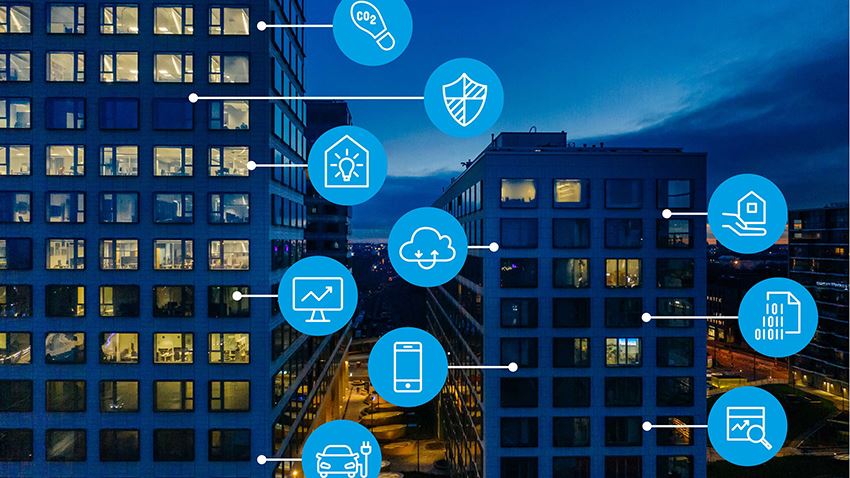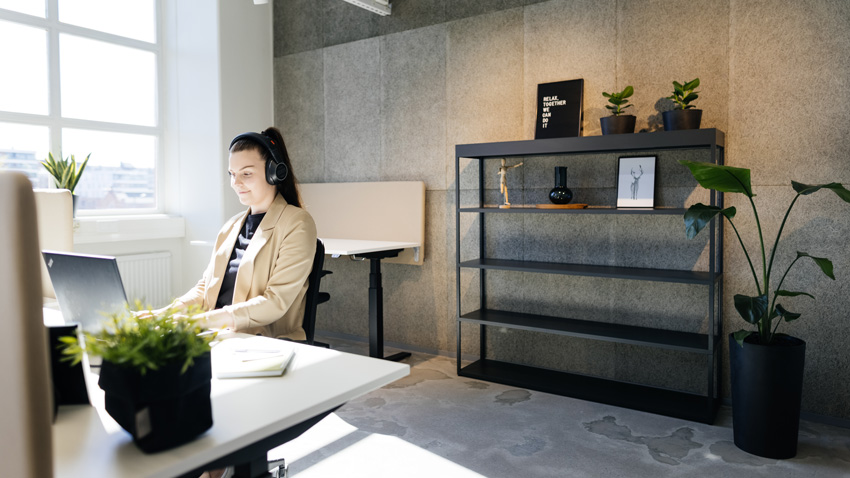Sustainable data centers as a service
- Construction
- Premises
- Renovation
- Offices
- Future of Work
- 11/23/2021
Smoothness and savings – smart buildings make everyday life easier for both users and owners
YIT’s Smart Building concept is leading the construction industry towards more open data and standard operating methods that will help to bring the benefits of smart buildings to property owners, maintenance and, above all, to users.

In all likelihood, we all have sometimes encountered problems related to building technology at work – for example, excess heat, cold, poor indoor air or disruptions in the flow of information caused by incompatible information systems. Professionals returning to their offices after the pandemic may dream of a workspace that knows how to actively maintain comfortable, environmentally friendly indoor conditions, support a seamless flow of information and predict its users’ needs with up-to-date data and feedback.
These dreams are no longer unattainable. Smart buildings that meet the needs of users have been designed by large construction and IT companies as well as engineering offices serving the real estate sector for a long time, and in recent years, the design has also started to bear fruit.
In Finland, one of the most recent examples is the modern Workery+ work space, which was opened in Vallila, Helsinki, in May 2021. It is a pilot project for the Smart Building concept(in Finnish), which will be implemented in YIT's new business premises.
Standardised data and practices play a key role
YIT’s Smart Building concept improves the comfort, efficiency, productivity and eco-friendliness of buildings by consolidating the data from all of the building’s technical systems on a single platform.
“Data is used and even produced in traditional construction, as well, but the challenge has been how to produce genuine added value for property owners and users from the fragmented data accumulated during a building’s design, construction and use. Data consolidation and a standardised way of processing and utilising data at all stages of the property's life cycle are at the core of the Smart Building concept. The concept uses the global RealEstateCore standard to consolidate data,” says Anders Stenbäck, VP, Offering and Services at YIT.
Design guidelines are also an important part of the consolidation and standardisation process, helping to implement the Smart Building concept in practice. The guidelines specify the technical and functional requirements for smart buildings, as well as instructions for the entire life cycle of the building, from design through construction to the use and maintenance phase. They enable all parties of the construction project to follow the concept and standards. It also benefits the life cycle services when their requirements are taken into account in the building’s design stage.
“With the Smart Building concept and design guidelines, we are taking a leap towards more open data and BIM models that move along the entire value chain during the life cycle of the property. The benefits of a smart building are now made available to the end-users and property maintenance in a standardised way. Things can be done in a more customer-oriented way while saving time and money. For example, people no longer need to use their working time to find information that is stored in separate silos,” Stenbäck says.
Smoother everyday life
The discussion around smart buildings and the opportunities they offer has been active for several years. Working life professors Heikki Ihasalo and Jaakko Ketomäki from Aalto University Smart Building Technologies and Services group, wrote already in 2018 that smart buildings are at the peak of the Gartner hype cycle (in Finnish).
They emphasise that smart buildings are much more than technical building systems. A smart building should, above all, make everyday life easier and smoother. According to the professors, in order to put the new smart functions into practice, construction projects need experts that have an overall view of the technical building systems and IT systems and, above all, an understanding of the needs of the users.
These needs can be increasingly diverse, as younger generations, especially those who have grown up in the digitalised world, are used to finding almost everything they need online. How can, for example, smarter office buildings meet the diverse needs of their users?

“For example, by making it easier to book premises and workstations, find information and colleagues, and adjust conditions according to one’s preferences. Seamless cooperation between data and services can both reduce and shorten waiting times, maintenance downtime and other unpleasant waiting in daily work,” says Stenbäck, who has been involved in promoting the development of YIT’s Workery+ business premises.
Moreover, the open and standardised approach can help to make the services in and around the building – such as public transport – more accessible to the user.
Fares well in international comparison
According to Stenbäck, new solutions that make everyday life easier are constantly being considered for the Workery+ business premises. Every customer at Workery+ can use an application to book workstations and meeting rooms as well as indicate when they are in the building. The booking data is also used for optimising the air conditioning and the number of dishes at the restaurant, for example.
“At Workery+, various sensors collect data not only on energy consumption and the indoor conditions of the property but also the way people move in the space, the routes they take within the office property and the use of the meeting rooms. The property management is based on software that shows, for example, to the property owner an overview of the energy efficiency and maintenance of the property,” Stenbäck says.
Smart buildings and the solutions implemented for them are attracting interest both in Finland and internationally. In Stenbäck’s view, the smart buildings implemented in Finland fare well in international comparison.
Workery+ Vallila represents the cutting edge of Finnish smart building design as it is the first property in Finland to be awarded the Platinum Smart Building certificate . The assessment criteria of the certificate include building usage, user experience and collaboration, building performance, building environment, integrative design and safety.

At the same time, Workery+ Vallila demonstrates that a smart building does not always have to be a new building. Before it became an office space focused on smart building solutions and applications, the building served as Telia’s headquarters. Sustainabilitywas one of the main priorities of the transformation project.
“I think Workery+ Vallila is an inspiring example of how even old buildings can benefit from intelligence and technology,” Stenbäck says.
Nicholas White, Smart Building Certification Co-Founder, has a similar opinion.
“The Vallila project focused on the user experience and the development of new business models and ways of managing the space with the help of smart technology. YIT scored very high marks for building performance, building environment and building usage. Special focus has been placed on user health, building sustainability and enhanced control and management,” White says.
Read more:



